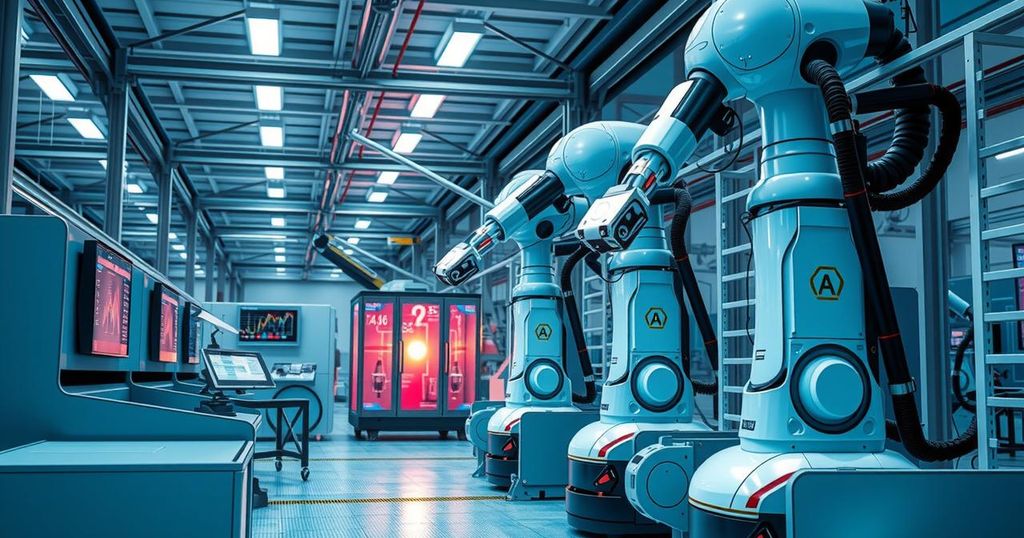Artificial Intelligence: A Transformative Force in Industrial Design
Artificial Intelligence is reshaping the industrial sector, enhancing production efficiency, product designs, and market competitiveness. Advanced techniques like machine learning and generative design enable real-time monitoring and robust analysis, but challenges related to technology adoption persist. A balanced approach between automation and human involvement is critical for maximizing AI’s benefits and securing a sustainable future.
In recent times, artificial intelligence is shaking up the industrial landscape, changing how companies think about production and product design. Utilizing complex techniques like deep learning and genetic algorithms, AI has established itself as a game changer—offering innovative, efficient, and customized product solutions. However, despite this monumental leap forward, the technology still grapples with a few holdbacks, posing questions about its broad acceptance in the industry.
As AI continues its surge, it encourages firms to embrace a more adept way of handling production processes, and honestly, it’s about time. We’re seeing enhanced product designs and fundamentally new approaches. There’s this constantly evolving ecosystem where companies with AI integration aren’t just keeping up; they’re building more sustainable production systems compared to their traditional counterparts. Such tools have been lurking in the shadows for years, yet now they’re finally shining as they redefine efficiency and creativity in manufacturing.
Machine learning and predictive analytics have become the watchwords for many businesses. With these in hand, manufacturers can now fine-tune every aspect of production. This can pinpoint areas for improvement, streamline resources, and potentially cut down operational costs. It’s the holy grail of contemporary manufacturing to maximize resource use while bolstering productivity and competitiveness in the marketplace. AI’s role in replicating complex human cognitive skills—like creativity and problem-solving—has found its niche, particularly in the realm of product design optimization.
Imagine this: AI processes mountains of historical data, market trends, and engineering criteria to whip up precise 3D models. It can even simulate how products perform under different conditions—tailoring custom solutions for users without ramping up costs. It’s revolutionary, and frankly, a bit mesmerizing. Another benefit comes from incorporating IoT and AI algorithms that monitor machines in real time, predicting when they might need service. This not only curbs maintenance costs but promises to minimize dreaded production downtimes.
Furthermore, intelligent machines born from AI integration are stepping into factories, designed to work alongside human operators. These aren’t just robots—they’re smart tools that adapt and learn, enhancing safety and productivity in the workplace. With the ability to tackle varying scenarios, these machines transform production lines into nimble operations, responsive to whatever market demands arise.
Quality control has taken its turn under the AI spotlight, and oh wow, the change has been dramatic. Automated systems are now checking quality with laser-like accuracy. Imperfections can be flagged in real-time, slicing down human error significantly. This proactive approach can save money by dealing with issues before they blow up into major headaches. And in this arena, computer vision stands out—analyzing productions at speeds and precision levels that are just beyond human reach.
So, here is where it gets really interesting: AI isn’t only about monitoring; it’s also about interpreting customer data. The holy grail—right again—is predicting future demand accurately, which helps retailers manage inventory smartly. Balancing AI support with human intuition can result in a safer and more efficient workplace. Generative Design AI is where the futuristic magic happens. Designers can access thousands of design options almost instantaneously, linking creativity with AI to supercharge innovation in product development.
Generative Design is a partnership between designers and machines, coaxing forth creative solutions that might be overlooked by mere human efforts. AI dives into a massive pool of potential designs, measuring against criteria set by designers and quickly turning around optimal options. This alone speeds up the process and unlocks that stubborn creativity that traditional methods often stifled due to constraints. It’s a whole new way of doing business.
In conclusion, the convergence of AI and industrial design is drastically altering the way products are conceptualized, developed, and produced. Sure, the hurdles surrounding data protection and the careful balance needed between automation and human input remain important discussions. But by investing in robust tech infrastructure and training, companies can turn these stumbling blocks into stepping stones towards a more efficient, competitive, and sustainable industry future.
In summary, the rise of artificial intelligence is undoubtedly reshaping industrial design and production processes, leading toward better efficiency and innovation. While challenges like technological limitations and data security linger, embracing AI, especially through generative design, demonstrates a promising way forward. Companies stand to benefit immensely from strengthening their tech foundations and fostering collaboration between humans and machines, thus optimizing productivity and product quality while moving towards sustainability.
Original Source: www.embedded.com




Post Comment